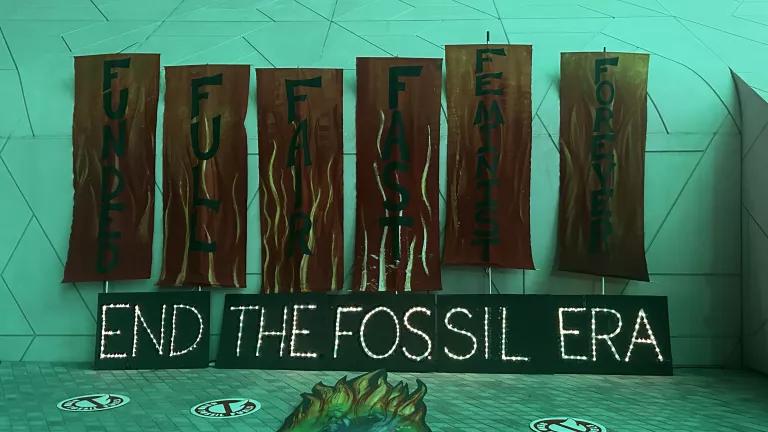What PJM Can Learn from MISO About Transmission Planning
PJM should enable smart transmission expansion that will benefit the entire region by taking a page out of MISO’s book.

Transmission lines.
GDJ via Rawpixel
To transition to a clean energy economy, we need a robust transmission grid made up of long-range, high-voltage power lines that can transport renewable energy from one place to another. Building more regional transmission lines will help keep the lights on during extreme weather events and help connect almost 3 terawatts of renewable energy currently waiting in line to provide clean, cheap power.
Regions of the U.S. power grid have begun planning for new transmission. Their plans work best if they include a set of future “scenarios” that reflect how the power system might look in 15 to 20 years. This ensures that new transmission, which will last a very long time, can meet the needs of the electricity system undergoing numerous changes.
As PJM Interconnection—the grid operator for 13 mid-Atlantic states and the District of Colombia—embarks on its first long term transmission planning process, it stands to learn from the grid operator of the Midwest (MISO), which completed their most recent round of long term planning in 2022. MISO has been doing long term planning since at least 2011, and has developed a robust planning process that supports utility and state future resource plans while ensuring that consumers benefit from low cost power and high levels of reliability. MISO’s most recent tranche of projects is expected to bring $37.3 billion in benefits to consumers and to connect 53 gigawatts of new clean energy by 2042. PJM should enable smart transmission expansion that will benefit the entire region by taking a page out of MISO’s book and using comprehensive and optimized planning.
In the planning process, PJM should:
- Ensure future planning scenarios include all state clean energy laws which will impact the power system by mandating renewable generation or carbon reduction.
- Consider the many benefits, as well as the costs, of new transmission projects.
- Evaluate groups of synergistic transmission projects at the same time, to ensure that all states see a benefit.
In their current process, PJM caves to fossil interests, stands to lose billions in revenue from clean energy incentives and job creation, and treats states with clean energy interests unfairly, explains NRDC’s Tom Rutigliano. We believe PJM can turn their process around by learning from their neighbor to the West.
Comprehensive Planning
A big takeaway from MISO is that accurate assumptions are paramount when planning for the future. While nobody can predict the future with 100% accuracy, MISO’s comprehensive planning includes a reasonable set of scenarios for what the grid might look like in 2040. These scenarios include new generation needed to meet state policies like Renewable Portfolio Standards, federal policies like the Inflation Reduction Act, different levels of load growth and electrification and economic considerations like the price of fuel.
MISO uses a more conservative scenario which assumes lower load growth and 40 percent decarbonization assumption, a medium scenario, and a more aggressive scenario which assumes a high rate of load growth and 80 percent decarbonization. The actual future grid will likely fall somewhere in the middle. Importantly, all three scenarios include meeting 100 percent of state clean energy policies. The specific assumptions in the futures are updated regularly to capture any known changes in utility plans, state and federal policies, and fuel prices.

MISO’s three scenarios for 2040, called “Futures,” show three different possibilities for how the electric system might look. All three scenarios include current and predicted future state clean energy policies.
PJM, on the other hand, proposed separating out state clean energy policies from other transmission needs. The region has proposed one future scenario, called their "base case," which does not evaluate the impact of state clean energy policies on the future electricity system. Instead, clean energy laws which will impact the amount of renewables in PJM are put on a different planning track.
State laws requiring clean energy are not hypothetical. They will have a real impact on the generation mix of the future. Leaving them out of PJM’s long-term planning “base case” will likely result in inefficient development of transmission lines, and force clean energy states to foot the bill for transmission that will benefit the whole region. For example, PJM might proceed with a project identified in their base case, only to find that state clean energy policies would have made a different project (or set of projects) more cost-effective.
All of MISO’s planning scenarios consider the impacts of state clean energy laws. PJM should also plan for a realistic future by ensuring that all factors that influence the electricity system are accounted for.
Optimized Planning
Another big takeaway from MISO’s process is that considering system-wide benefits optimizes transmission solutions to keep costs low for consumers. After developing plans that use accurate assumptions about the future, MISO identifies solutions that offer important benefits, including avoided costs from local resource and transmission investments, savings from avoided energy losses and reduced outages, improved reliability during extreme weather events, and decarbonization. This allows MISO to choose solutions that maximize overall benefits and reduce costs.

Some of the benefits that MISO uses to evaluate transmission projects. These benefits are compared to a project’s total cost, and projects with a higher benefit to cost ratio move forward to the next stage.
In PJM’s base case, they only plan to evaluate projects necessary to maintain reliability. But, as MISO showed, it is important that they evaluate benefits as broadly as possible. As explained in a report by the Energy Systems Integration Group and exemplified through MISO’s successful process, evaluating many types of benefits can help accurately measure the value that transmission can bring to a region. Without all benefits included in the evaluation, some transmission lines that would otherwise have benefited consumers will not be built.
PJM’s plan optimizes transmission solutions in their base case based on two factors: the location of new generation that is already waiting in the "queue" to connect to the grid, and the ability of a project to avoid blackouts. It does not identify projects needed to meet state clean energy policies, to reduce costly congestion, or any of the other factors MISO considers. While most of the resources in the queue are renewable, they will barely meet state policy-driven demand for clean energy by 2027 in PJM, according to NRDC analysis. State clean energy policies may result in a significant number of new resources that aren't currently planned for in PJM's base case process.
PJM also needs to co-optimize both for new generation costs and transmission costs. Since PJM is optimizing transmission solutions based on the queue, it is not considering how a different set of transmission and generation additions could reduce overall costs to consumers. Developers who have new resources waiting in the queue have likely chosen the most cost-effective locations based on generation costs alone but may not consider transmission costs when siting a new power plant. It is PJM’s role to additionally consider transmission costs and plan for the lowest overall transmission and generation grid to meet state policies and maintain reliability.
While PJM proposed to evaluate one project at a time, MISO evaluates the estimated benefits of groups of projects all together. There were 18 new transmission lines proposed and evaluated at the same time in MISO as part of the successful “Tranche 1” process. By evaluating projects together, MISO can ensure that it captures the combined benefits of all the lines working together and that every state benefits from the transmission. For example, a line may allow Minnesota to meet its ambitious clean energy standards, and a neighboring line will help North Dakota keep the lights on during severe winter storms. To ensure all states benefit and keep costs low, PJM should consider synergistic portfolios of projects instead of evaluating one project at a time.
PJM doesn’t have to reinvent the wheel.
The region can learn from MISO to keep costs low and plan accurately to meet the needs of the generation shift that is underway in the PJM states.
This round of planning will result in the only large transmission PJM builds this decade. We understand the need to move quickly, but PJM must also get it right. If not, this planning process may result in transmission delays, increased costs to consumers, and even risks not building enough transmission to meet state clean energy statutes and further backing up the queue.
PJM still has time to improve. It’s much easier to make a robust process from the start, rather than fixing predictable problems later. PJM should take a page out of MISO’s book and adopt realistic future scenarios that consider the impacts of state clean energy policies among the range of needs driving new transmission. The RTO should also choose projects based on a broad range of benefits that potential transmission will bring to the region, and evaluate portfolios of projects to ensure synergistic benefits are captured and every state benefits. Transmission remains paramount to an affordable, reliable clean energy future, and PJM can show leadership in its transmission planning process.




